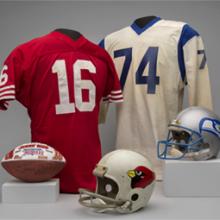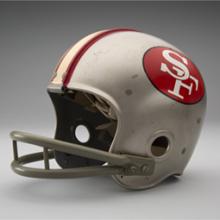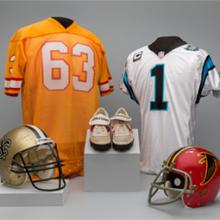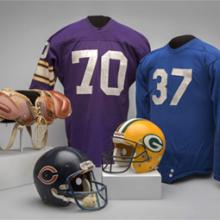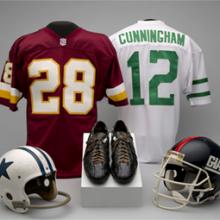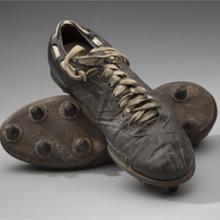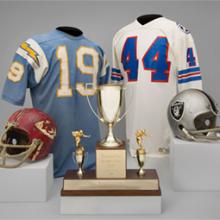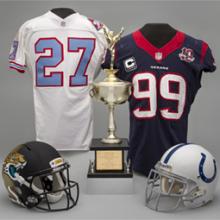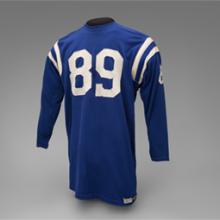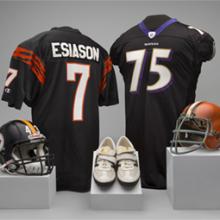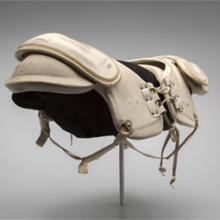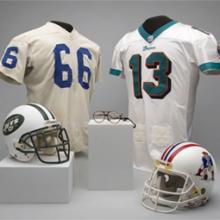Terminal 3
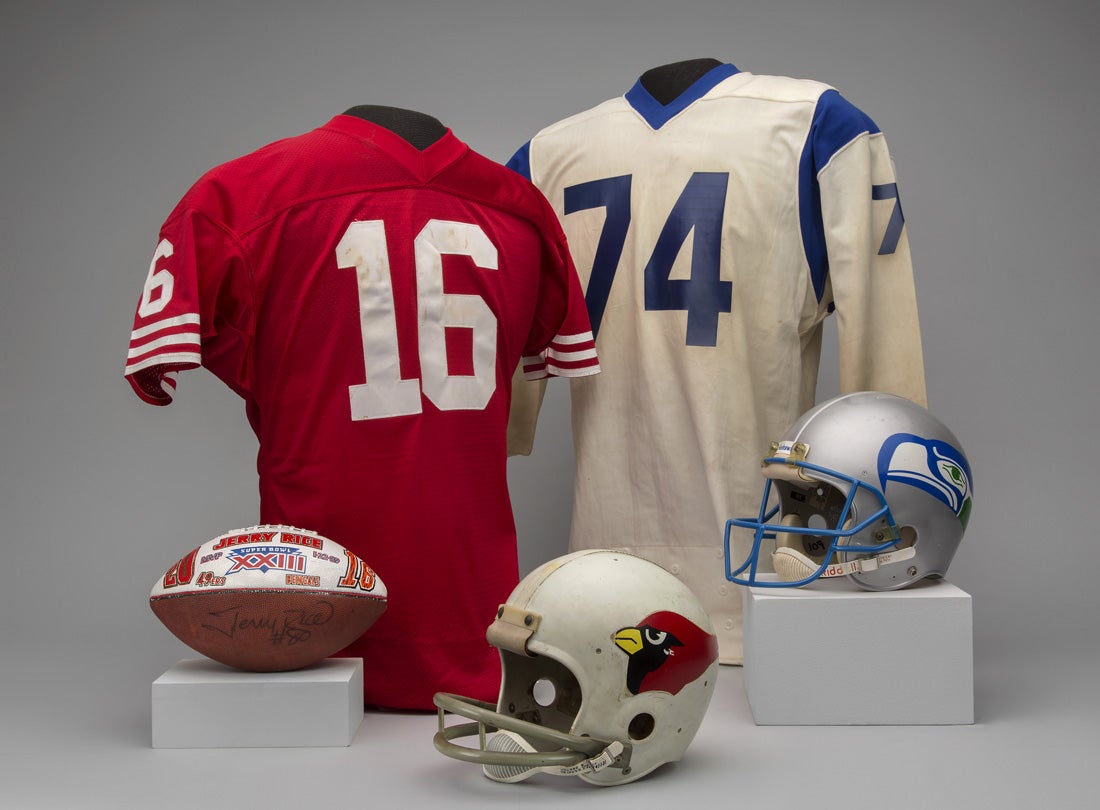
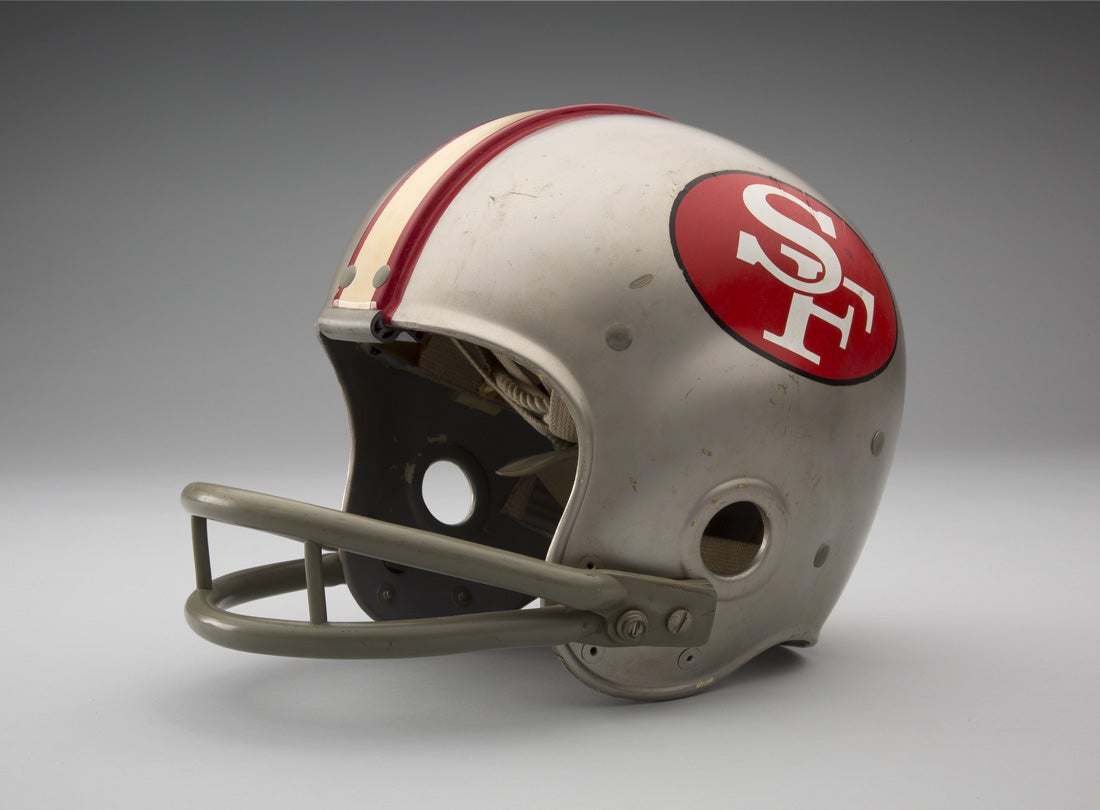
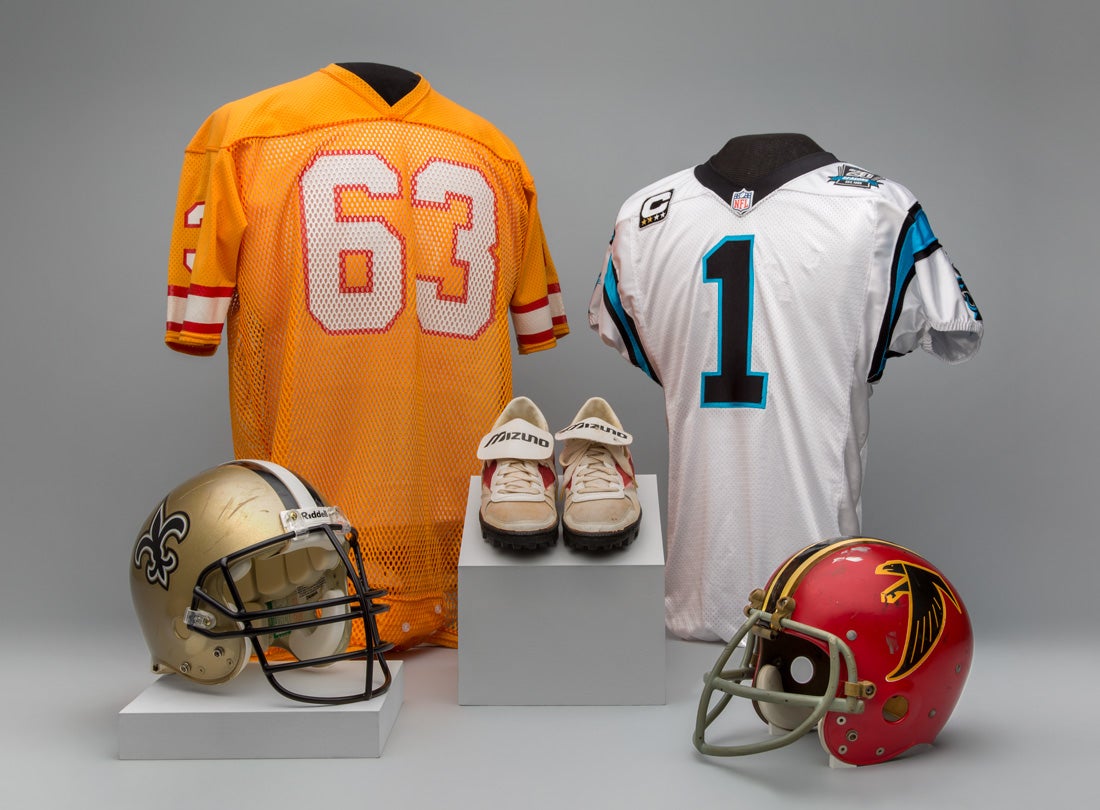
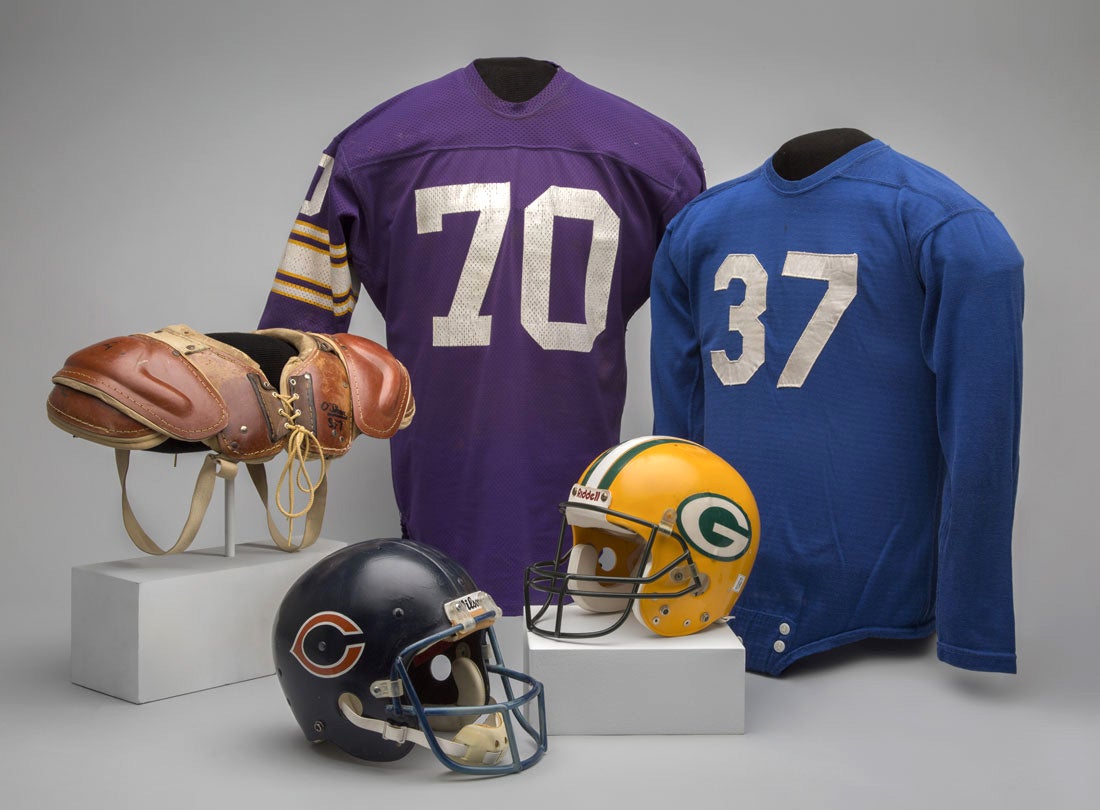




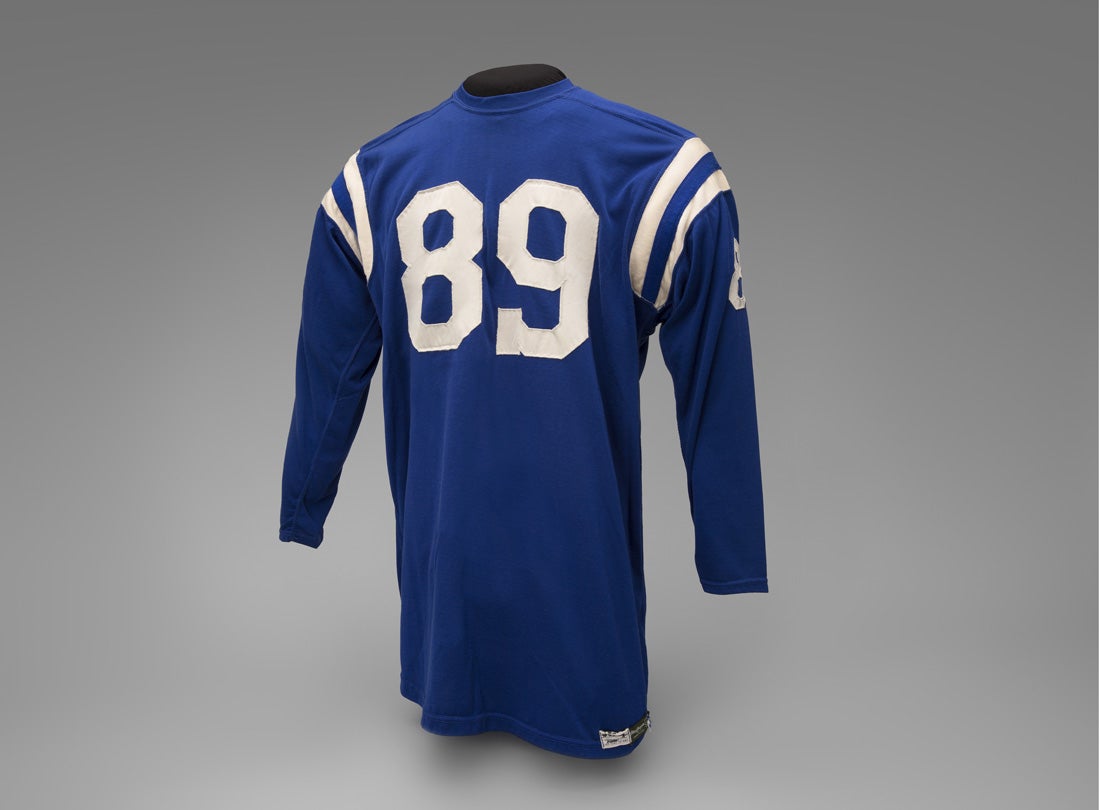
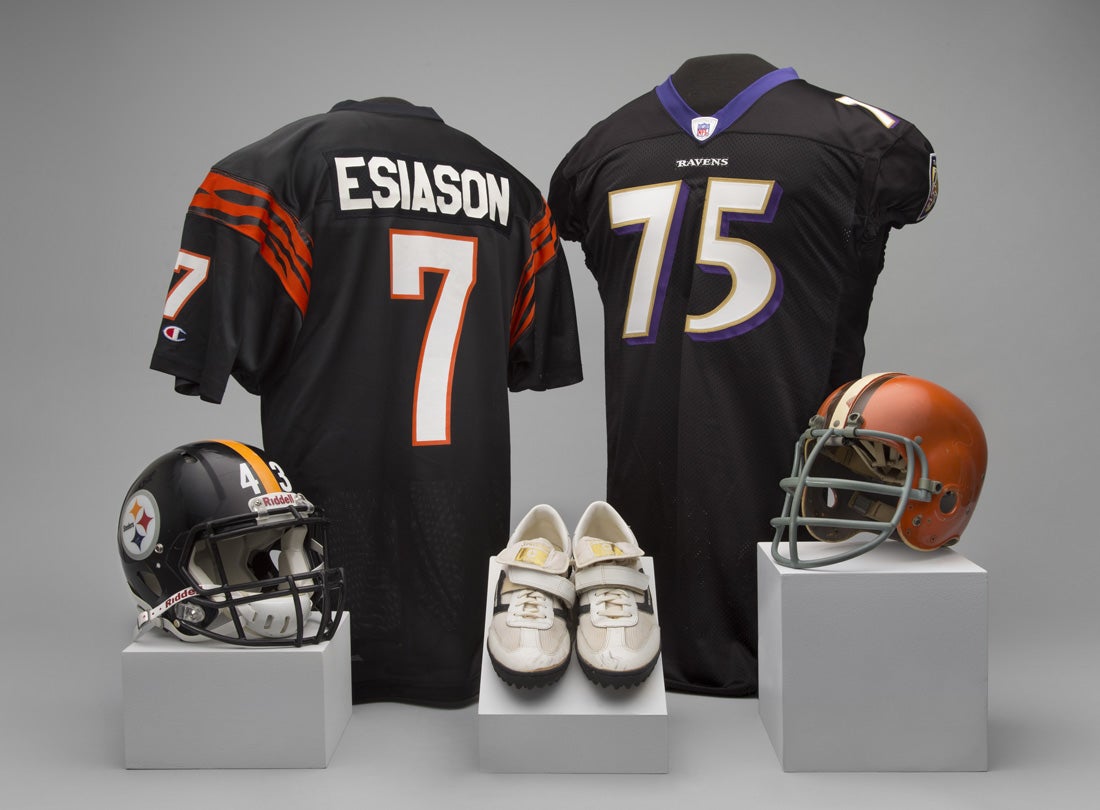


|
Football signed by Super Bowl XXIII MVP Jerry Rice 1989 |
Jersey worn by |
Helmet worn by |
Jersey worn by |
Helmet worn by |
![]()
San Francisco 49ers
A charter member of the All-America Football Conference, the 49ers began play in 1946. One of the more dominant teams in the AAFC, San Francisco joined the National Football League in 1950 and forged a close relationship with its fans while playing at intimate Kezar Stadium in Golden Gate Park. The team enjoyed success in the early 1970s after moving to Candlestick Park, but rose to the top of the National Football League only after the arrivals of head coach Bill Walsh and quarterback Joe Montana in 1979. The team was a dominant force throughout the 1980s and much of the 1990s, capturing five world championships with wins in Super Bowls XVI, XIX, XXIII, XXIV, and XXIX.
Super Bowl Appearances: XVI (1981), XIX (1984), XXIII (1988), XXIV (1989), XXIX (1994), XLVII (2012)
Bold indicates victory

St. Louis Rams
Cleveland Rams 1937–42, 1944–45; Los Angeles Rams 1946–94; St. Louis Rams 1995–present
The Cleveland Rams joined the National Football League in 1937. The Rams struggled for several seasons, but their fortunes improved in 1945 with the arrival of star quarterback Bob Waterfield, who led the team to the NFL championship that year. The Rams were the first major sports team to move to the West Coast when they relocated to Los Angeles in 1946. The team slipped in the late 1950s and early 1960s, but returned as a league power in the late 1960s and 1970s with a defensive unit anchored by tackle Merlin Olsen. The team moved to St. Louis after the 1994 season and won Super Bowl XXXIV in 1999, marking the team's first NFL title since 1951.
NFL Championships: 1945, 1951
Super Bowl Appearances: XIV (1979), XXXIV (1999), XXXVI (2001)
Bold indicates victory
![]()
Arizona Cardinals
Chicago Cardinals 1920–43; Card-Pitt 1944; Chicago Cardinals 1945–59; St. Louis Cardinals 1960–87; Phoenix Cardinals 1988–93; Arizona Cardinals 1994-present
The Arizona Cardinals are the oldest professional football franchise in the United States. Founded in Chicago in 1898 as the Morgan Athletic Club, the team was renamed the Cardinals for the color of the used University of Chicago jerseys they wore. The Chicago Cardinals won NFL championships in 1925 and 1947. The team moved to St. Louis in 1960 and adopted the cardinal bird logo that season. During the 1970s, the Cardinals established one of the league’s most effective offenses behind an offensive line anchored by tackle Dan Dierdorf. In 1988, the Cardinals moved to Arizona. In 2008, the team won the NFC title and earned a berth in Super Bowl XLIII.
NFL Championships: 1925, 1947
Super Bowl Appearances: XLIII (2008)
Bold indicates victory
![]()
Seattle Seahawks
The Seahawks entered the National Football League in 1976 as an expansion team. They built their offense around quarterback Jim Zorn and wide receiver Steve Largent, who proceeded to break every major NFL receiving record. By Seattle's third season, the Seahawks posted a winning record, which they repeated in 1979. The 1980s featured more winning ways with several playoff appearances. The team advanced to the AFC championship for the first time in 1983 and claimed its first division title in 1988. In 2013 and 2014, the Seahawks won back-to-back NFC championships, defeating the Denver Broncos in Super Bowl XLVIII and narrowly losing Super Bowl XLIX to the New England Patriots.
Super Bowl Appearances: XL (2005), XLVIII (2013), XLIX (2014)
Bold indicates victory
Helmet worn by Leo Nomellini (San Francisco 49ers defensive tackle, 1950-63) c. 1962
Pro Football Hall of Fame, Class of 1969
Courtesy of the Pro Football Hall of Fame Collection
H-61
L2015.1502.203

San Francisco 49ers defensive tackle Leo Nomellini prepares to tackle
Los Angeles Rams running back Joe Marconi December 4, 1960
Credit: Pro Football Hall of Fame
|
Helmet worn by |
Jersey worn by |
Cleats worn by |
Jersey worn by |
Helmet worn by Tommy Nobis |

Tampa Bay Buccaneers
The Buccaneers joined the National Football League as an expansion team in 1976. After suffering a league-record twenty-six consecutive losses, the team quickly reversed its misfortunes and made the playoffs in 1979, 1981, and 1982—reaching the NFC Championship Game in just its fourth season. The following year, the team returned to its struggling ways and suffered through fourteen consecutive losing seasons before becoming a regular fixture in the playoffs beginning in 1997, the year the team abandoned its now-infamous “Creamsicle” uniforms and “Buccaneer Bruce” helmets. In 2002, the team’s league-leading defense helped the Buccaneers win their first world championship with a victory in Super Bowl XXXVII.
Super Bowl Appearances: XXXVII (2002)
Bold indicates victory

Carolina Panthers
The Panthers joined the National Football League in 1995 and finished with seven wins and nine losses, establishing a new NFL record for wins by an expansion team. In their second season, the Panthers claimed a division title and advanced to the conference title game. After a return to the middle of the pack and only two seasons removed from a 1-15 season, Carolina defeated the Philadelphia Eagles to win the 2003 NFC championship and gain its first Super Bowl berth. After the arrivals of quarterback Cam Newton in 2011 and linebacker Luke Kuechly in 2012, the Panthers returned to their winning ways and reached the playoffs in 2013 and 2014.
Super Bowl Appearances: XXXVIII (2003)
Bold indicates victory
![]()
Atlanta Falcons
The Atlanta Falcons joined the National Football League as an expansion team in 1966. The team struggled to a 3-11 record in its inaugural season, but fans were encouraged by the outstanding play of the Falcons’ number one draft pick, linebacker Tommy Nobis, who earned Rookie of the Year honors. Atlanta registered its first winning season in 1971, but really emerged as a contender with their record-setting “Grits Blitz” defense in the late 1970s. Defensive end Claude Humphrey played a critical role as a premier pass-rush specialist. One year after the arrival of head coach Dan Reeves in 1997, Atlanta won the NFC championship and earned a berth in Super Bowl XXXIII.
Super Bowl Appearances: XXXIII (1998)
Bold indicates victory
![]()
New Orleans Saints
New Orleans was awarded a National Football League franchise in 1966 and began play in the 1967 season. For many years, quarterback Archie Manning was the team’s only marquee player. Devoted fans suffered through twenty consecutive non-winning seasons before the arrivals of team owner Tom Benson and general manager Jim Finks, who helped turn the Saints into winners with a 12-3 record in 1987 and a division title in 1991. In 2006, head coach Sean Payton and quarterback Drew Brees arrived and helped the franchise become one of the elite teams in the NFL. In 2009, the Saints reached the top of the football world with a victory in Super Bowl XLIV.
Super Bowl Appearances: XLIV (2009)
Bold indicates victory
|
Shoulder pads worn by George Musso |
Helmet worn by Walter Payton when he broke Jim Brown’s career rushing record October 7, 1984 |
Jersey worn by |
Helmet worn by James Lofton c. 1983 |
Jersey worn by |

Minnesota Vikings
The Minnesota Vikings joined the National Football League as an expansion team in 1960 and took the field in 1961. Their name was selected to reflect the area’s large population of Scandinavian Americans. In their very first game, rookie quarterback Fran Tarkenton came off the bench to lead Minnesota to a shocking 37-13 upset victory over the Chicago Bears. Since their founding, the Vikings have maintained one of the highest winning percentages in the NFL. Their “Purple Gang” defense, led by tackle Alan Page and ends Carl Eller and Jim Marshall, helped the Vikings win the NFL championship in 1969 and three NFC crowns during the 1970s.
NFL Championships: 1969
Super Bowl Appearances: IV (1969), VIII (1973), IX (1974), XI (1976)
Bold indicates victory

Detroit Lions
Portsmouth Spartans 1930–33; Detroit Lions 1934–present
After three seasons in a small river town in Ohio, the Portsmouth Spartans relocated to Detroit in 1934. The team was renamed the Lions as a nod to that city’s baseball team, the Tigers, with whom they shared Tiger Stadium. The team enjoyed its greatest success during the 1950s, with a high-powered offense led by quarterback Bobby Layne and halfback-kicker-punter Doak Walker. The Lions won three NFL championships during that decade. Following Layne’s departure in 1958, the Lions were largely unsuccessful for the next twenty-five years. After the arrival of running back Barry Sanders in 1989, the team returned to its winning ways and made six playoff appearances during the 1990s.
NFL Championships: 1935, 1952, 1953, 1957
Super Bowl Appearances: none
![]()
Chicago Bears
Decatur Staleys 1920; Chicago Staleys 1921; Chicago Bears 1922–present
The Chicago Bears, one of the league’s charter members, began play as the Decatur Staleys in central Illinois. The team moved to Chicago in 1921 and was renamed to reference the city’s baseball team, the Cubs, with whom they shared Wrigley Field. Owner George "Papa Bear" Halas selected orange and blue as the team’s colors to honor his alma mater, the University of Illinois. The Bears have an illustrious history and count twenty-seven representatives in the Pro Football Hall of Fame. Most of the team’s successes can be attributed to Halas, who was involved as a player, coach, and owner from the franchise’s founding in 1920 until his death in 1983. Chicago has won nine NFL championships, including Super Bowl XX in 1985.
NFL Championships: 1921, 1932, 1933, 1940, 1941, 1943, 1946, 1963
Super Bowl Appearances: XX (1985), XLI (2006)
Bold indicates victory

Green Bay Packers
The Green Bay Packers formed in 1919 and joined the National Football League in 1921. They remain the last vestige of “small town teams” that predominated in the NFL during the league’s first two decades. The Packers were one of the league’s first dynastic teams during the 1930s. During the 1960s, head coach Vince Lombardi led the team to nine consecutive winning seasons and five NFL championships, including victories in the first two Super Bowls. Green Bay earned two more Super Bowl titles in 1996 and 2010, further reinforcing Green Bay’s longstanding nickname, "Titletown USA." The Packers are the only nonprofit, community-owned major league professional sports team in the United States.
NFL Championships: 1929, 1930, 1931, 1936, 1939, 1944, 1961, 1962, 1965, 1966, 1967
Super Bowl Appearances: I (1966), II (1967), XXXI (1996), XXXII (1997), XLV (2010)
Bold indicates victory
|
Helmet worn by |
Jersey worn by |
On-field shoes worn by Tom Landry 1979 |
Jersey worn by Randall Cunningham 1994 |
Helmet worn by |

Philadelphia Eagles
Philadelphia Eagles 1933–43; Phil-Pitt 1943; Philadelphia Eagles 1944–present
The Philadelphia Eagles were formed in 1933, providing the young National Football League with representation in another major city. The team struggled through much of its first decade and merged with the Pittsburgh team in 1943 due to roster depletion caused by World War II. The Eagles experienced their first success beginning in 1944, with six consecutive winning seasons and back-to-back NFL championships in 1948 and 1949. After several decades of highs and lows, the team became a league power again in the 1980s, earning a berth in Super Bowl XV. The Eagles have frequently returned to contention and made their second Super Bowl appearance in the 2004 season.
NFL Championships: 1948, 1949, 1960
Super Bowl Appearances: XV (1980), XXXIX (2004)
Bold indicates victory

New York Giants
The establishment of the New York Giants in 1925 and their immediate success helped the young National Football League gain national media attention and a larger fan base. To distinguish themselves from the popular New York Giants baseball team, they established themselves as “New York Football Giants,” a name they maintain nearly sixty years after Major League Baseball’s Giants moved to San Francisco. New York Giants fans are among the most passionate in the league, and the team currently has more than 135,000 fans waitlisted for season tickets. The Giants have won eight NFL championships, including victories in Super Bowls XXI, XXV, XLII, and XLVI.
NFL Championships: 1927, 1934, 1938, 1956
Super Bowl Appearances: XXI (1986), XXV (1990), XXXV (2000), XLII (2007), XLVI (2011)
Bold indicates victory
![]()
Washington Redskins
Boston Braves 1932; Boston Redskins 1933–36; Washington Redskins 1937–present
The Washington Redskins originated as the Boston Braves in 1932. In 1937, the team moved to Washington, D.C., and won their first NFL championship that year. The Redskins were led by rookie sensation “Slingin’ Sammy” Baugh, who helped make the forward pass an integral part of NFL offenses in the 1940s. After a lengthy playoff drought, head coach George Allen arrived in 1971 and promptly led the Redskins to four consecutive playoff appearances and an AFC title in 1972. In 1981, the Redskins returned to their winning ways under head coach Joe Gibbs, with eight playoff appearances over the next eleven years and victories in Super Bowls XVII, XXII, and XXVI.
NFL Championships: 1937, 1942
Super Bowl Appearances: VII (1972), XVII (1982), XVIII (1983), XXII (1987), XXVI (1991)
Bold indicates victory
![]()
Dallas Cowboys
The Dallas Cowboys joined the National Football League as an expansion team in 1960 and struggled during their first six seasons. Under head coach Tom Landry, the team turned its fortunes around in 1966 and reached the NFL championship game. The Cowboys established themselves as one of the league's dynastic teams by posting twenty consecutive winning seasons beginning in 1966, appearing in five Super Bowls during the 1970s, and winning Super Bowls VI and XII. In the 1990s, the Cowboys added three more titles with victories in Super Bowls XXVII, XXVIII, and XXX. Dubbed “America’s Team” by their loyal fans, their regular season success and frequent return to the playoffs have resulted in the Cowboys’ tremendous popularity nationwide.
Super Bowl Appearances: V (1970), VI (1971), X (1975), XII (1977), XIII (1978), XXVII (1992), XXVIII (1993), XXX (1995)
Bold indicates victory
Cleats worn by Sam Huff (New York Giants linebacker, 1956–63) during his rookie season 1956
Pro Football Hall of Fame, Class of 1982
Courtesy of the Pro Football Hall of Fame Collection
S-061

Linebacker Sam Huff at momentary rest on the New York Giants’ bench 1950s
Credit: Pro Football Hall of Fame
|
Helmet worn by |
Jersey worn by |
Associated Press Coach of the Year trophy awarded to Hank Stram 1966 |
Final jersey worn by Floyd Little |
Helmet worn by |
![]()
Oakland Raiders
Oakland Raiders 1960–81; Los Angeles Raiders 1982–94; Oakland Raiders 1995–present
The Oakland Raiders were established in 1960 as a charter franchise in the American Football League. After three consecutive losing seasons, the team hired Al Davis as head coach in 1963. By 1965, the team established itself as one of the most dominating forces in professional sports. Beginning that season, the Raiders recorded winning records in nineteen of their next twenty seasons. With a roster of players that included some of the league’s most colorful personalities and a well-earned reputation for hard-nosed play on the field, the team became closely identified with its host city—particularly with the increased success during the 1970s. The team won the AFL Championship Game in 1967 and three NFL titles with victories in Super Bowl XI, XV, and XVIII.
AFL Championships: 1967
Super Bowl Appearances: II (1967), XI (1976), XV (1980), XVIII (1983), XXXVII (2002)
Bold indicates victory

San Diego Chargers
Los Angeles Chargers 1960; San Diego Chargers 1961–present
The Chargers were established in 1960 as a charter franchise in the American Football League. With a tremendous offensive attack, the team claimed five division titles during its first six seasons and won the 1963 AFL championship. One of the team’s early stars was wide receiver Lance Alworth, nicknamed “Bambi” for his slender build, speed, and tremendous leaping ability. The late 1970s and early 1980s saw the Chargers return as one of pro football's great offenses under innovative head coach Don Coryell and quarterback Dan Fouts. San Diego was successful again in the 1990s with a berth in Super Bowl XXIX, and the team has earned five division titles since 2004.
AFL Championships: 1963
Super Bowl Appearances: XXIX (1994)
Bold indicates victory
![]()
Denver Broncos
The Denver Broncos were established in 1960 as a charter franchise in the American Football League. Although the team’s performance during the first decade of their history was less than stellar, the Broncos became one of pro football's leading teams after the AFL-NFL merger was completed in 1970. Beginning in 1976, the Broncos were bolstered by the “Orange Crush,” one of the league’s top run defenses, and did not have a losing season from 1976 to 1981. During the 1980s and 1990s, the Broncos were conference champions five times and won consecutive NFL championships in Super Bowl XXXII and Super Bowl XXXIII behind quarterback John Elway.
Super Bowl Appearances: XII (1977), XXI (1986), XXII (1987), XXIV (1989), XXXII (1997) XXXIII (1998), XLVIII (2013)
Bold indicates victory
![]()
Kansas City Chiefs
Dallas Texans 1960–62; Kansas City Chiefs 1963–present
After Texas oil tycoon Lamar Hunt’s proposal to establish an expansion team in Dallas was rebuffed by the National Football League, Hunt cofounded the American Football League and started his own team, the Dallas Texans. By their third year, the Texans won the AFL title, then relocated to Kansas City and became the Chiefs. Under head coach Hank Stram, the franchise recorded the best record in the ten-year history of the AFL, highlighted by an appearance in the first Super Bowl and a victory in Super Bowl IV behind quarterback Len Dawson. The Chiefs returned to their winning ways in 1990 and reached the playoffs in seven of their next eight seasons.
AFL Championships: 1962, 1966, 1969
Super Bowl Appearances: I (1966), IV (1969)
Bold indicates victory
|
Helmet worn by |
Jersey worn by |
Outstanding Defensive Player of the Year Trophy awarded to Curley Culp 1975 |
Jersey worn by |
Helmet worn by |

Tennessee Titans
Houston Oilers 1960–96; Tennessee Oilers 1997–98; Tennessee Titans 1999–present
A charter member of the American Football League in 1960, the Houston Oilers won back-to-back titles in 1960 and 1961 and made the playoffs five times during the league’s ten-year tenure. After consecutive one-win seasons in 1972 and 1973, the Oilers’ fortunes began to turn around when Bum Phillips was hired to coach the team in 1974. The Oilers returned to the playoffs for three consecutive seasons beginning in 1978 behind the league’s leading rusher, running back Earl Campbell. The team relocated to Nashville, Tennessee, in 1997. The team was renamed the Titans in 1999, winning the AFC championship that season and earning a berth in Super Bowl XXXIV.
AFL Championships: 1960, 1961
Super Bowl Appearances: XXXIV (1999)
Bold indicates victory

Jacksonville Jaguars
The Jaguars enjoyed quick success after joining the National Football League as an expansion team in 1995. In just their second season, Jacksonville qualified for the playoffs and made it to the American Football Conference championship game—the first of four consecutive post-season appearances. In 1999, the team compiled a league-best 14-2 regular season record and once again made it to the AFC title game. Their early success was largely fueled by the passing prowess of quarterback Mark Brunell and wide receivers Keenan McCardell and Jimmy Smith. In 2006, the Jaguars drafted running back Maurice Jones-Drew, who was named to the Pro Bowl three times and led the league in rushing in 2011.
Super Bowl Appearances: none
![]()
Houston Texans
The Houston Texans joined the National Football League as an expansion franchise in the American Football Conference in 2002, returning professional football to a city that had seen their Oilers team depart for Nashville, Tennessee, in 1997. The Texans defeated their cross-state rivals, the Dallas Cowboys, 19-10 in the franchise's regular season opener, marking the first time that an expansion team won its opening game since the Minnesota Vikings' stunning upset of the Chicago Bears in 1961. The team won the first of its two consecutive AFC South Division titles in 2011, and won its first postseason game on January 7, 2012, with a 31-10 victory over the Cincinnati Bengals.
Super Bowl Appearances: none

Indianapolis Colts
Baltimore Colts 1953–83; Indianapolis Colts 1984–present
The Colts began in Baltimore in 1953 and were named in honor of that city’s history of horse breeding and racing. The team’s defense was led by outstanding defensive end Gino Marchetti, and they established a potent passing game in 1956 with the arrival of Johnny Unitas, whose strong arm and celebrity status made him the prototype of the modern era quarterback. The Colts claimed back-to-back NFL titles in 1958 and 1959, and won the league championship again in 1968 and Super Bowl V in 1970. The team relocated to Indianapolis in 1984. The Colts added another league title in 2007 with a victory over the Chicago Bears in Super Bowl XLI.
NFL Championships: 1958, 1959, 1968
Super Bowl Appearances: III (1968), V (1970), XLI (2006), XLIV (2009)
Bold indicates victory
Jersey worn by Gino Marchetti (Baltimore Colts defensive end, 1953–64, 1966) c. 1960
Pro Football Hall of Fame, Class of 1972
Courtesy of the Pro Football Hall of Fame Collection
J-83

Baltimore Colts defensive end Gino Marchetti (89) tackles Los Angeles Rams running back
Jon Arnett (26) at the Los Angeles Memorial Coliseum December 12, 1959
Credit: Pro Football Hall of Fame
|
Helmet worn by |
Jersey worn by Boomer Esiason during his MVP season 1988 |
Cleats worn by |
Jersey worn by Jonathan Ogden during a 27-13 Ravens victory over the Cleveland Browns November 7, 2004 |
Helmet worn by |

Cleveland Browns
Cleveland Browns AAFC 1946–49; 1950–95, 1999–present
The Cleveland Browns first took the field as members of the National Football League’s rival All-America Football Conference in 1946. After capturing that league's title in each of the four seasons the AAFC existed, the Browns moved to the NFL in 1950. Cleveland's domination continued as the Browns advanced to the NFL championship game six consecutive seasons and won league crowns in 1950, 1954, and 1955. The franchise added a fourth NFL championship in 1964. Team owner Art Modell announced plans to move the team to Baltimore in 1995. The league allowed the Baltimore Ravens to be established as a new franchise with Browns personnel, while Cleveland maintained all Browns intellectual property. The Cleveland Browns resumed operations as an expansion team in 1999.
NFL Championships: 1950, 1954, 1955, 1964
Super Bowl Appearances: none
![]()
Cincinnati Bengals
The Cincinnati Bengals joined the American Football League as an expansion team in 1968. Although the name Buckeyes was selected in a fan poll, ownership chose the name Bengals to honor the professional team that played in that city from 1937 to 1942. By 1970, the Bengals won their division to become the first expansion team to win a championship of any kind in just three years. In 1981, sporting new uniforms and helmets with tiger-stripe patterns, Cincinnati advanced to its first of two appearances in the Super Bowl. The Bengals have earned playoff berths in four consecutive seasons since acquiring quarterback Andy Dalton in the 2011 draft.
Super Bowl Appearances: XVI (1981), XXIII (1988)
Bold indicates victory
![]()
Baltimore Ravens
In 1996, Baltimore was awarded the Ravens as a new team with Cleveland Browns personnel, returning pro football to a city with a rich tradition that had been without a team since the Colts’ departure in 1984. The team’s name was inspired by a nineteenth-century poem written by one of the city’s most famous former residents, Edgar Allan Poe. With a veteran group of players and a stock of young talent, success soon followed as the Ravens built their identity around a talented and hard-nosed defensive team. The Ravens have reached the playoffs ten times since 2000 and earned victories in Super Bowls XXXV and XLVII.
Super Bowl Appearances: XXXV (2000), XLVII (2012)
Bold indicates victory
![]()
Pittsburgh Steelers
Pittsburgh Pirates 1933–39; Pittsburgh Steelers 1940–42; Phil-Pitt 1943; Card-Pitt 1944; Pittsburgh Steelers 1945–present
Founded in 1933 and first known as the Pittsburgh Pirates, the team changed its name to the Steelers in 1940 to reflect the predominant industry of the area. The franchise struggled for many of its first forty years, but made up for those tribulations with success in the 1970s. They built an impressive offensive unit around quarterback Terry Bradshaw and assembled one of the best defenses in league history. Pittsburgh advanced to the playoffs eight consecutive seasons during that decade and won four Super Bowl championships in a six-year span. The team added a fifth Super Bowl crown in 2006 and then became the first team to win six Super Bowls with a 26-23 victory over the Arizona Cardinals in Super Bowl XLIII.
Super Bowl Appearances: IX (1974), X (1975), XIII (1978), XIV (1979), XXX (1995), XL (2005), XLIII (2008), XLV (2010)
Bold indicates victory
Shoulder pads worn by Jim Brown (Cleveland Browns running back 1957–65) c. 1963
Pro Football Hall of Fame, Class of 1971
Courtesy of the Pro Football Hall of Fame Collection
SP-04

Browns running back Jim Brown (32) rushes behind guard Jim Wooten (60)
with Vikings defensive tackle Gary Larsen (77) in pursuit October 31, 1965
Credit: Pro Football Hall of Fame
|
Helmet worn by |
Jersey worn by |
Prescription eyeglasses worn on the field by Bob Griese during the 1978 Pro Football Hall of Fame Game |
Jersey worn by |
Helmet worn by |
![]()
Buffalo Bills
The Buffalo Bills were founded as a charter franchise of the American Football League in 1960. Their name was selected to honor the city’s defunct AAFC team that had played in the late 1940s. One of pro football's dominant teams of the 1960s, Buffalo captured back-to-back league titles in 1964 and 1965. After suffering some highs and lows through the years, the Bills returned to prominence in the late 1980s and 1990s. With a defense anchored by defensive end Bruce Smith and an offense centered around quarterback Jim Kelly, running back Thurman Thomas, and wide receiver Andre Reed, Buffalo became the first team to reach the Super Bowl in four consecutive seasons.
AFL Championships: 1964, 1965
Super Bowl Appearances: XXV (1990), XXVI (1991), XXVII (1992), XXVIII (1993)
Bold indicates victory
![]()
Miami Dolphins
The Dolphins joined the American Football League in 1966 and became one of pro football's most successful teams under head coach Don Shula, who arrived in 1970. In 1972, the team posted the NFL's only perfect season with a 17-0 record, which was topped by a 14-7 victory over the Washington Redskins in Super Bowl VII. The team followed up the next season with a 24-7 victory over the Minnesota Vikings in Super Bowl VIII, with fullback Larry Csonka rushing for 145 yards and earning MVP honors. The Dolphins returned to prominence in the 1980s and earned berths in Super Bowls XVII and XIX.
Super Bowl Appearances: VI (1971), VII (1972), VIII (1973), XVII (1982), XIX (1984)
Bold indicates victory
![]()
New York Jets
New York Titans 1960–62; New York Jets 1963–present
The New York Titans were founded as a charter franchise in the American Football League in 1960. In 1963, the team’s home field was relocated from the Polo Grounds to Shea Stadium near LaGuardia Airport and they were renamed the Jets, changing their color scheme from blue-and-gold to green-and-white. In 1968, the Jets won the AFL championship and prepared to face the NFL champion Baltimore Colts, considered at the time to be one of the greatest teams in pro football history. Led by a brash young quarterback, Joe Namath, the Jets accomplished a stunning upset victory over the Colts in Super Bowl III, the first NFL Championship game to officially bear the name “Super Bowl.”
AFL Championships: 1968
Super Bowl Appearances: III (1968)
Bold indicates victory
![]()
New England Patriots
Boston Patriots 1960–70, New England Patriots 1971–present
The Patriots were founded as a charter franchise in the American Football League in 1960 and played as the Boston Patriots through 1970. After the AFL-NFL merger, the team was renamed the New England Patriots. The Patriots made a memorable run at a Super Bowl title in 1985, winning three playoff games on the road before falling to the Bears in Super Bowl XX. More recently, the team’s extraordinary success under the leadership of head coach Bill Belichick and quarterback Tom Brady has yielded three Super Bowl championships in a four-year span and a recent victory in Super Bowl XLIX, assuring the Patriots a prominent place in NFL history as one of the league’s dynastic teams.
Super Bowl Appearances: XX (1985), XXXI (1996), XXXVI (2001), XXXVIII (2003), XXXIX (2004), XLII (2007), XLVI (2011), XLIX (2014)
Bold indicates victory
